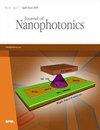Synthesis and characteristics of BaYF5:Yb3+, Er3+@BaYF5 nanoparticles as a new near-infrared fluorescence bioimaging probe
IF 1.1
4区 物理与天体物理
Q4 NANOSCIENCE & NANOTECHNOLOGY
引用次数: 0
Abstract
Abstract. Fluorescent bioimaging technology has been widely used in clinic because of its high sensitivity, quick feedback, and no radiation. Among them, NIR-II imaging has lower absorption, tissue scattering, self-fluorescence, and higher signal-to-noise ratio. As a precursor of nanoprobe, BaYF5 is an excellent material due to its low phonon energy, which makes it easy to achieve rare earth ion energy level transition and obtain strong upconversion luminescence. A near-infrared II (NIR-II) rare earth fluoride nanoparticle (NP) BaYF5 : Yb3 + , Er3 + @ BaYF5 has been constructed. The luminescence principle of the material was deeply analyzed, and the influence of different doping ion ratio on fluorescence intensity was explored. Finally, the optimal doping ratio for this matrix material was obtained. In addition, according to the surface properties of the materials, the water solubility and biocompatibility of the NPs were significantly improved by the modification. Our work also systematically tested and analyzed the cytotoxicity, hematotoxicity, and tissue toxicity of the NPs and finally realized the high-resolution fluorescence imaging in living mice. This NP can be used as an effective and safe NIR-II contrastive agent, which provides the possibility for the detection and monitoring of physiological activity under deep tissue in vivo.新型近红外荧光生物成像探针BaYF5:Yb3+,Er3+@BaYF5纳米粒子的合成与表征
摘要荧光生物成像技术具有灵敏度高、反馈快、无辐射等优点,在临床上得到了广泛的应用。其中,NIR-II成像具有较低的吸收、组织散射、自荧光和较高的信噪比。作为纳米探针的前驱体,BaYF5是一种优异的材料,因为它具有较低的声子能量,可以很容易地实现稀土离子的能级跃迁并获得强的上转换发光。近红外II(NIR-II)稀土氟化物纳米粒子(NP)BaYF5 : Yb3 + , Er3 + @ BaYF5已经建成。深入分析了该材料的发光原理,探讨了不同掺杂离子比对荧光强度的影响。最后,得到了该基体材料的最佳掺杂率。此外,根据材料的表面性质,改性显著提高了纳米颗粒的水溶性和生物相容性。我们的工作还系统地测试和分析了NPs的细胞毒性、血液毒性和组织毒性,最终实现了活体小鼠的高分辨率荧光成像。该NP可作为一种有效、安全的NIR-II对比剂,为体内深层组织下生理活性的检测和监测提供了可能。
本文章由计算机程序翻译,如有差异,请以英文原文为准。
求助全文
约1分钟内获得全文
求助全文
来源期刊

Journal of Nanophotonics
工程技术-光学
CiteScore
2.60
自引率
6.70%
发文量
42
审稿时长
3 months
期刊介绍:
The Journal of Nanophotonics publishes peer-reviewed papers focusing on the fabrication and application of nanostructures that facilitate the generation, propagation, manipulation, and detection of light from the infrared to the ultraviolet regimes.
 求助内容:
求助内容: 应助结果提醒方式:
应助结果提醒方式:


